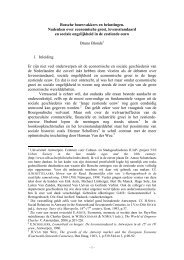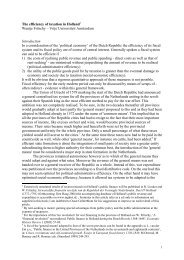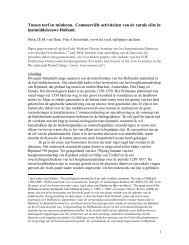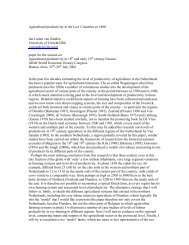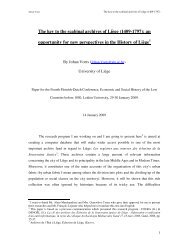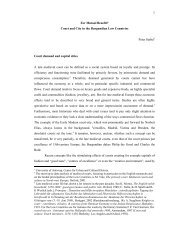Amsterdam as the cradle of modern futures and options trading ...
Amsterdam as the cradle of modern futures and options trading ...
Amsterdam as the cradle of modern futures and options trading ...
Create successful ePaper yourself
Turn your PDF publications into a flip-book with our unique Google optimized e-Paper software.
Endnotes<br />
1<br />
The authors would like to thank Nico van Horn for research <strong>as</strong>sistance. Abbreviations in text: ACA,<br />
<strong>Amsterdam</strong> City Archives; DNA, Dutch National Archives; NA, Notarial Archives<br />
2<br />
Cf. for instance: P.J. Blok, “Mémoire touchant le negoce et la navigation des holl<strong>and</strong>ois...”, in: Bijdragen en<br />
Mededeelingen van het Historisch Genootschap, 24 (1903), 221-342, at 234; M.F.J. Smith, Tijdaffaires aan de<br />
<strong>Amsterdam</strong>sche beurs (Nijh<strong>of</strong>f: The Hague 1919) 96-101; J.G. van Dillen, ‘Termijnh<strong>and</strong>el te <strong>Amsterdam</strong> in de 16e<br />
en 17e eeuw’, in: De economist 76 (1927) 503-523; V. Barbour, Capitalism in <strong>Amsterdam</strong> in <strong>the</strong> Seventeenth<br />
Century (John Hopkins Press: Baltimore 1950), 74-80; H. van der Wee, ‘Monetary, credit, <strong>and</strong> banking systems’, in:<br />
E.E. Rich, Ch. Wilson, ed., The Cambridge economic history <strong>of</strong> Europe V (Cambridge 1977) 240-392. Richard<br />
Ehrenberg also insisted that wagers were <strong>the</strong> forerunner <strong>of</strong> derivates, though he recognizes potential benefits <strong>of</strong><br />
derivatives <strong>of</strong> derivative <strong>trading</strong>: D<strong>as</strong> Zeitalter der Fugger, Geldkapital und Creditverkehr im 16. Jahrhundert, II,<br />
Die Weltbörsen und Finanzkrisen des 16. Jahrhunderts (Fischer: Jena 1896), 308.<br />
3<br />
For an analysis <strong>of</strong> contemporary Dutch attitudes to speculation <strong>and</strong> particularly windh<strong>and</strong>el, see N. De Marchi <strong>and</strong><br />
P. Harrison, ‘Trading “in <strong>the</strong> Wind” <strong>and</strong> with Guile: The Troublesome Matter <strong>of</strong> <strong>the</strong> Short Selling <strong>of</strong> Shares in<br />
Seventeenth-Century Holll<strong>and</strong>’, in N. De Marchi <strong>and</strong> M.S. Morgan, eds., Higgling, transactors <strong>and</strong> <strong>the</strong>ir markets in<br />
<strong>the</strong> history <strong>of</strong> economics (Duke University Press: Durham 1994), 47-65. Swan, Building <strong>the</strong> global market 78-79; cf.<br />
E.H. Krelage, Bloemenspeculatie in Nederl<strong>and</strong>, de Tulpomanie van 1636-1637 en de Hyacintenh<strong>and</strong>el 1720-1736<br />
(Van Kampen: <strong>Amsterdam</strong> 1942) 95-96, referring to Dutch court considerations about this point, elaborated by <strong>the</strong><br />
German philosopher <strong>of</strong> law R. Stammler, ‘Die Harlemer Tulpenmanie’, in: Deutsches Rechtsleben im alten Reich 1<br />
(1928).<br />
4 th<br />
Cf. for instance R.A. Brealey, S.C. Myers, Principles <strong>of</strong> corporate finance (Mc Graw Hill: New York, 4 ed<br />
1991), 483-504; ‘Greenspan, unlike Buffett, sees derivatives <strong>as</strong> positive influence’, The New York Times March<br />
8, 2003 p. C14; ‘Off target’, ‘Buffetted’, in: The Economist March 15, pp 14 <strong>and</strong> 74 respectively.<br />
5<br />
E.J. Swan, Building <strong>the</strong> global market, a 4000 year history <strong>of</strong> derivatives (Kluwer Law: The Hague 2000) 28-29,<br />
36-37. On 139-221, Swan jumps from Antwerp to London; G. Poitr<strong>as</strong>, The early history <strong>of</strong> financial economics,<br />
1478-1776, from commercial arithmetics to life annuities <strong>and</strong> joint stocks (Elgar: Cheltenham 2000) 335-381, gives a<br />
far more comprehensive picture, including <strong>the</strong> emergence <strong>of</strong> rice <strong>futures</strong> in 18 th century Japan described in full by U.<br />
Schaede, ‘Forwards <strong>and</strong> <strong>futures</strong> in Tokugawa period Japan’, in: Journal <strong>of</strong> banking <strong>and</strong> finance 13 (1989) 487-513.<br />
6<br />
J. Penso de la Vega, Confusion de confusiones (<strong>Amsterdam</strong> 1688). Complete Dutch edition by G.J. Geers/M.F.J.<br />
Smith, Nijh<strong>of</strong>f, The Hague 1939; a selection <strong>of</strong> <strong>the</strong> text in English translation by H. Kellenbenz, Cambridge M<strong>as</strong>s<br />
1957, republished by M.S. Fridson, New York 1996; The first economic historian to draw attention to De la Vega’s<br />
work w<strong>as</strong> Richard Ehrenberg: ‘Die <strong>Amsterdam</strong>er Aktienspekulation im 17. Jahrhundert’, in: Conrad’s Jahrbücher<br />
für NationalÖkonomie und Statistik 3. Folge III. B<strong>and</strong> (1892) 809-826; About De la Vega: J.I. Israel, 'The<br />
<strong>Amsterdam</strong> stock exchange <strong>and</strong> <strong>the</strong> English revolution <strong>of</strong> 1688', in: Tijdschrift voor geschiedenis 103 (1990) 412-<br />
440; idem, ‘Een merkwaardig literair werk en de <strong>Amsterdam</strong>se effectenmarkt in 1688: Joseph Penso de la Vega’s<br />
Confusion de confusiones’, in: De zeventiende eeuw 6 (1990) 159-161<br />
7<br />
Ch. Wilson, Anglo-Dutch commerce <strong>and</strong> finance in <strong>the</strong> eighteenth century (CUP: Cambridge 1941), 79-87; P.G.M.<br />
Dickson, The financial revolution in Engl<strong>and</strong>, a study in <strong>the</strong> development <strong>of</strong> public credit 1688-1756 (OUP:<br />
Oxford 1967), 491, 507-510; L. Neal, The rise <strong>of</strong> financial capitalism, international capital markets in <strong>the</strong> age <strong>of</strong><br />
re<strong>as</strong>on (CUP: Cambridge 1990) 16-19, 141-165; R.C. Michie, ‘The invisible stabilizer, <strong>as</strong>set arbitrage <strong>and</strong> <strong>the</strong><br />
international monetary system since 1700’, in: Financial history review 5 (1998) 5-26.<br />
8<br />
Sayous, ‘Spéculation’, 38-46; W.S. Unger, ‘De Holl<strong>and</strong>sche graanh<strong>and</strong>el en Graanh<strong>and</strong>elspolitiek in de<br />
Middeleeuwen’, De Economist 65 (1916), 243-269, 337-386, 461-486, at 365-366; Van Dillen, Termijnh<strong>and</strong>el,<br />
p<strong>as</strong>sim<br />
9<br />
Cf. J.G. van Dillen, 'Isaac le Maire en de h<strong>and</strong>el in actiën der Oost-Indische Compagnie', in: Economisch-historisch<br />
jaarboek 16 (1930) 1-165. Also: O. Gelderblom <strong>and</strong> J. Jonker, ‘Completing a financial revolution, <strong>the</strong> finance <strong>of</strong><br />
<strong>the</strong> Dutch E<strong>as</strong>t India trade <strong>and</strong> <strong>the</strong> rise <strong>of</strong> <strong>the</strong> <strong>Amsterdam</strong> capital market, 1595-1612’, forthcoming.<br />
10<br />
M. D<strong>as</strong>h, Tulipomania, <strong>the</strong> story <strong>of</strong> <strong>the</strong> world’s most coveted flower <strong>and</strong> <strong>the</strong> extraordinary p<strong>as</strong>sions it aroused<br />
(London 1999); Cf. also E.H. Krelage, Bloemenspeculatie in Nederl<strong>and</strong>, de Tulpomanie van 1636-1637 en de<br />
Hyacintenh<strong>and</strong>el 1720-1736 (Van Kampen: <strong>Amsterdam</strong> 1942); Idem, ‘Het manuscript over den tulpenwindh<strong>and</strong>el<br />
uit de verzameling-Meulman’, in: Economisch-Historisch jaarboek 22 (1940-1942) 26-48; A series <strong>of</strong> still<br />
indispensable documents w<strong>as</strong> published by N.W. Posthumus, ‘De speculatie in tulpen in de jaren 1636 en 1637’, in:<br />
Economisch-Historisch Jaarboek 12 (1926), 3-99; Idem, 13 (1927) 1-85; Idem, 18 (1934).<br />
11<br />
Swan, Building, 5; Poitr<strong>as</strong>, History 335; P.L. Bernstein, Against <strong>the</strong> gods, <strong>the</strong> remarkable story <strong>of</strong> risk (Wiley:<br />
New York 1996) 304-306.<br />
12<br />
R. Levine, ‘Financial development <strong>and</strong> economic growth: views <strong>and</strong> agenda’, in: Journal <strong>of</strong> economic<br />
literature 35 (1997) 688-726.<br />
13<br />
Sayous, ‘Speculation’; De Marchi & Harrison, ‘Trading’<br />
14<br />
Poitr<strong>as</strong>, Early History, 348.<br />
20



